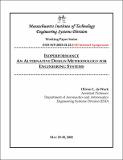Isoperformance An Alternative Design Methodology for Engineering Systems
Author(s)
de Weck, Olivier L.
Downloadesd-wp-2003-01.22.pdf (236.6Kb)
Metadata
Show full item recordAbstract
Tradeoffs between performance, cost and risk frequently arise during architecting and design of complex Engineering Systems such as aerospace vehicles. A paradigm shift is occurring from the pure performance optimization approach of the past towards satisfying of performance targets under concurrent risk and cost minimization. This paper proposes “isoperformance” as a set based approach to designing engineering systems by first identifying the acceptable performance invariant set of designs from which a final design is chosen. This is in contrast to a multiobjective cost-risk minimization under performance equality constraints. This paper identifies a number of issues associated with finding the desired performance invariant set, I, given a deterministic or empirical system model that maps design variables x to objective variables J. Isoperformance is presented as a methodology that can quantify and visualize the tradeoffs between determinants (independent design variables) of a known or desired outcome. For deterministic systems the multivariable performance invariant contours can be computed using sensitivity analysis and a contour following algorithm, provided that a mathematical system model of appropriate fidelity exists. In the case of stochastic systems the isoperformance curves can be obtained via a regression analysis, given a statistically representative data set. Once isoperformance curves have been obtained, they are useful in extracting a set of performance invariant solutions. Applying additional objectives, other than performance, can then lead to a set of pareto-optimal designs. Specific examples from opto-mechanical space systems design and human factors are presented.
Date issued
2002-05Publisher
Massachusetts Institute of Technology. Engineering Systems Division
Series/Report no.
ESD Working Papers;ESD-WP-2003-01.22-ESD Internal Symposium